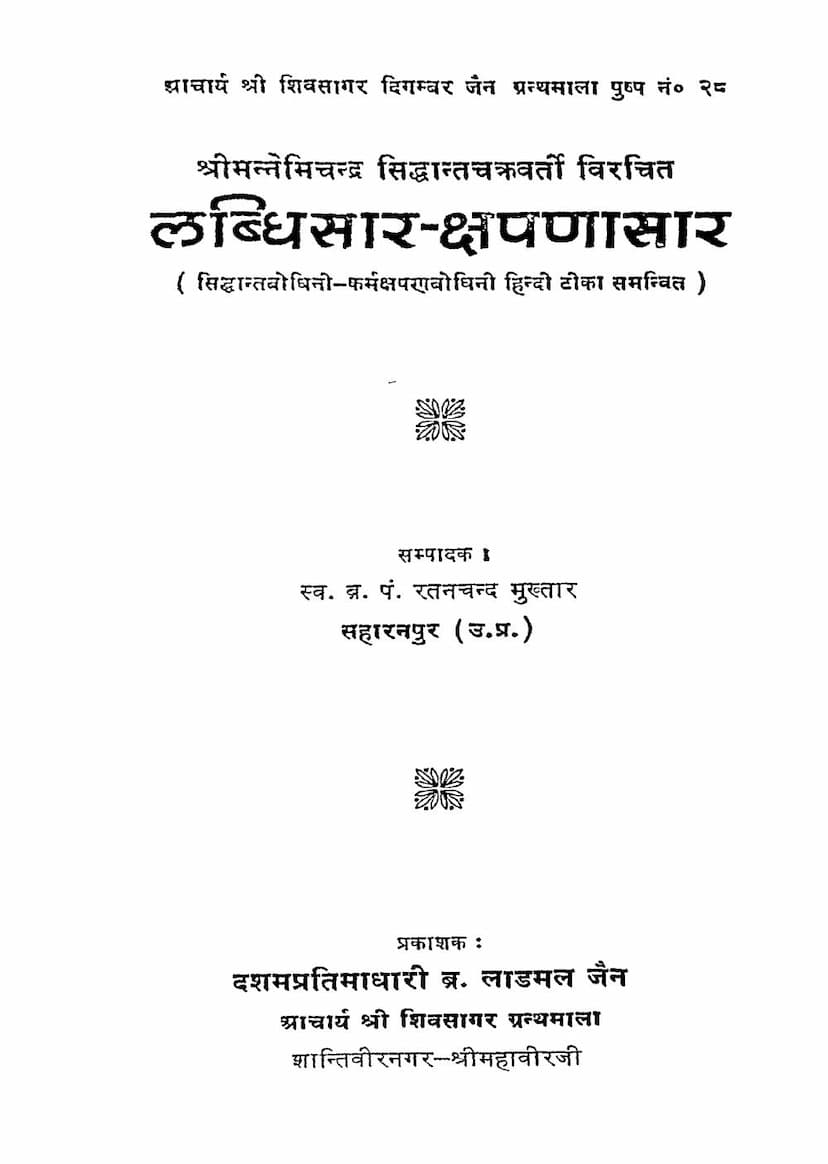Labdhisara Kshapanasara
Added to library: September 2, 2025

Summary
The provided Jain text, "Labdhisara Kshapanasara," authored by Ratanchand Mukhtar, is a significant work within Jain philosophy, particularly focusing on the spiritual path towards liberation. The title itself, "Labdhisara Kshapanasara," translates to "The Essence of Gains" and "The Essence of Destruction (of Karma)," indicating its dual focus on achieving spiritual powers (labdhi) and the ultimate destruction of karmic bonds (kshapan).
Here's a breakdown of the text's content based on the provided pages:
Core Themes and Structure:
The text is a commentary and compilation based on the profound works of great Jain Acharyas like Nemichandra Siddhanta Chakravarti. It delves deeply into the "KarananuYoga," one of the fourfold analysis of Jain scriptures, which focuses on the practical application of spiritual principles and the intricacies of karma.
Key Concepts and Content:
-
Foundation in Earlier Works: The text establishes its lineage by referencing foundational Jain scriptures such as the Shatkhandagama Sutras (preserved by Acharyas Pushpadanta and Bhutabali) and Kashaya Pahuda (authored by Acharya Gunadhara). It highlights the extensive commentaries (Dhavala, Jayadhavala, and Mahadhavala) written by Swami Virasena on these works. The "Labdhisara Kshapanasara" is presented as a synthesis and clarification of these profound teachings for a modern audience.
-
Focus on "Labdhi" (Gains/Powers): The first part, "Labdhisara," likely details the various spiritual powers and attainments ("labdhi") that a soul can acquire on the path to liberation. This would typically include aspects like the nature of the soul, the types of karmas, and the subtle states of consciousness that lead to supernatural abilities.
-
Focus on "Kshapan" (Destruction of Karma): The second part, "Kshapanasara," concentrates on the process of "kshapan," which is the deliberate and systematic destruction or shedding of karmic particles that bind the soul to the cycle of birth and death. This involves the detailed explanation of the stages of spiritual purification, the shedding of specific karmas, and the subtle practices involved in spiritual advancement.
-
Commentary and Modernization: The text is presented with a Hindi commentary titled "Siddhantabodhini-Karma Kshapanabodhini." This indicates a dual goal: to illuminate the deep philosophical and practical aspects of the original Jain principles ("Siddhanta Bodhini") and to explain the process of karma destruction ("Karma Kshapanabodhini"). The editor, the late Pt. Ratanchand Mukhtar, is credited with this valuable contribution, making the text accessible to modern readers, particularly those familiar with Hindi.
-
Authorship and Context: The text is attributed to the great Jain Acharya Nemichandra Siddhanta Chakravarti, who composed it for Chamundaraya. The publisher, Dashampratimadhari Bra. Ladmal Jain, and the editor, Pt. Ratanchand Mukhtar, are recognized for their role in bringing this work to light. The publication is part of the "Acharya Shri Shivasagar Digambar Jain Granthamala," suggesting a lineage and dedication to disseminating Jain scriptures.
-
Specific Chapters/Content: The "Vishay Prayojan" (Subject Introduction) and "Vishay Anukramanika" (Subject Index) provide a glimpse into the specific topics covered:
- Fivefold Labdhis: The text discusses the five spiritual gains (labdhi): Kashayopasham (mitigation of passions), Vishuddhi (purity), Deshana (instruction), Prayogya (readiness/suitability), and Karana (process/action).
- Bandha-Avasarana: It explains the process of karma bondage and its gradual descent or shedding.
- Karanas: The text elaborates on the "three Karanas" (Adhah Pravritta, Apurva Karana, and Anivrittikarana) which are crucial stages in the path of karma destruction.
- Upashamana and Kshapan of Karmas: It details the processes of "upashamana" (pacification) and "kshapan" (destruction) of specific karmas, particularly focusing on the Mohaniya (delusion-inducing) karma.
- Specific Karmas: The text covers the detailed stages of shedding karmas like Mohaniya (Darshan Mohaniya and Charitra Mohaniya), Kashayas (anger, pride, deceit, greed), Vedas (sexes), and other karmic states.
- Stages of Spiritual Progress: It likely outlines the progression through various spiritual stages and the associated modifications in karmic influx and shedding.
- Mathematical and Astronomical References: The text's inclusion of concepts like "Phalyasankhyabhag" (an innumerable fraction of a Palya, a unit of time) suggests the use of complex calculations and astronomical references, typical of Jain Cosmology and Karma theory.
Overall Significance:
"Labdhisara Kshapanasara" is a comprehensive treatise that aims to provide a deep understanding of the practical path to spiritual liberation as taught in the Digambara Jain tradition. By building upon the foundational texts and offering a clear Hindi commentary, it serves as a vital resource for spiritual seekers wanting to understand and implement the principles of karma shedding and the attainment of spiritual powers. The work emphasizes the meticulous and gradual process required for spiritual purification and ultimate freedom from karmic bondage.